229 Search Results for partner strategies
April 14, 2019
by Carole Zangari -
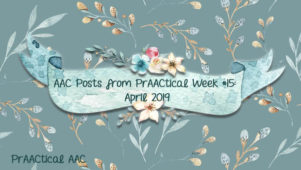
Good morning, AAC friends. Here are the posts we published this week. Monday – AACtivity of the Month: Concept Sorts Tuesday – AAC Link Up Wednesday – Video of the Week: Strategies for Supporting AAC Team Buy-In & Implementation Thursday – How I do it: Using Videos & Instructional Feedback to Support Communication Partners ::::::::::::::::::::::::::::::::::::::::::::::::::::::::::::::::::::::::::::::::::::::::::::::::::::::::::::::::::::::::::::::: Have time for a little more browsing? Check out these past posts. When Helping Isn’t Helping-Prompt Awareness in AAC Instruction Administratively Speaking: 5 Considerations for Recruiting and Retaining AAC SLPs AAC In the Classroom: Considerations for Modeling Core Vocabulary How I Do It: A Year of Core Word in Action AAC in the High School Classroom: Where Core Vocabulary Meets Life Skills
February 11, 2019
by Carole Zangari -
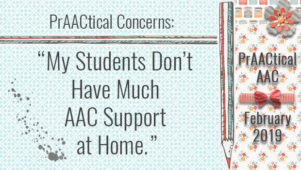
At a conference last month, I had some wonderful interactions with teachers and SLPs who are incredibly dedicated to helping their students with AAC needs become more proficient communicators. A number of common threads emerged through comments like these. “It’s really frustrating! My student would make SO much more progress if there was carryover at home.” “I keep telling my student’s parents this but they don’t really follow through.” “I’ve told them about the research and shared a lot of web links with them, but nothing seems to change. My student’s family still doesn’t really use his AAC at home.” “The family tells me that they are modeling AAC, but when I look at the ‘history’ it shows that not much AAC is happening outside of school hours.” In person and through social media, professionals have shared their stories and expressed that they are sometimes surprised and puzzled but mostly disappointed... [Read More...]
December 3, 2018
by Carole Zangari -
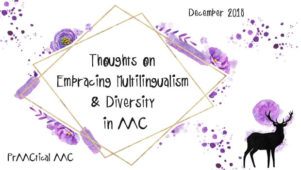
How can we best support learners with complex communication needs who come from a variety of cultural and linguistic backgrounds? Today, we turn the reins over to Arizona-based SLP Deanna Wagner who shares her thoughts on embracing and encouraging multilingualism and diversity in our AAC work. ::::::::::::::::::::::::::::::::::::::::::::::::::::::::::::::::::::::::::::::::::::::::::::::::::::::::::::::::::::::::::::::::::::::::::::::: My latest article on cultural diversity has just been published in the ASHA Special Issue on Cultural and Linguistic Diversity and AAC, guest edited by Gloria Soto! That means that ASHA members who have a Special Interest Group affiliation can access it and receive CEU credit for studying the content and answering a few questions. Since not all readers are members of an ASHA SIG, I would like to take a moment to share my experiences in preparing the manuscript that I submitted for this article. Most importantly, as people who serve the needs of those who benefit from AAC, we all need... [Read More...]
November 15, 2018
by Carole Zangari -
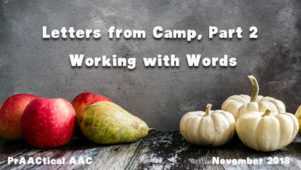
The weather is nippy here in Boston where 12,000+ professionals are gathered for the annual ASHA Convention, and the blustery wind makes us think back longingly to the warmer days of summer. Today. Ohio-based SLP Tina Moreno helps us do just that as she returns to share more information on the reading and writing activities that AAC learners in Camp ALEC experienced. In today’s post, she shares some of the details about Working with Words. If you missed it the first time, you can visit Tina’s earlier post here. Many thank to AAC mom and SLP Tina Moreno for giving us a peek into the wonderful instruction provided to these AAC learners! ::::::::::::::::::::::::::::::::::::::::::::::::::::::::::::::::::::::::::::::::::::::::::::::::::::::::::: Working with Words at Camp ALEC At Camp ALEC in August, our literacy counselors planned fun, motivating activities that helped our campers learn to read and write new words. In another setting, we might refer to these... [Read More...]
November 12, 2018
by Carole Zangari -
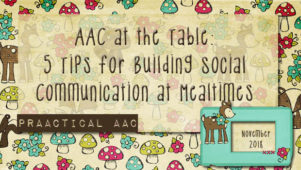
Think back on some of the meals that you’ve shared with others recently. What did people talk about? In most cases, there’s a lot more that ‘Pass the peas,’ ‘What’s for dessert?’, and ‘Can I go now?’ Mealtimes are social experiences in many cultures and it can take some work to ensure that our AAC learners can take part. Here are some ideas for supporting the development of social communication during shared meals. Build a routine that includes social communication: AAC learning takes time and lots of prAACtice. We can support the march to AAC proficiency by incorporating specific kinds of social exchanges into our mealtimes so that AAC learners know what the expect and have practice opportunities for this skill set at mealtime. Some examples: Sharing Time (i.e.., everyone shares something that happened to them that was funny/interesting/memorable), Question of the Day (e.g., “What’s your favorite __?” “Where’s the... [Read More...]
November 8, 2018
by Carole Zangari -
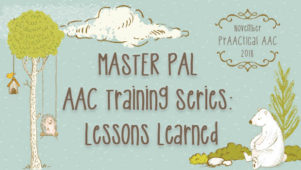
Thanks to all who reached out to express appreciation for Tabi Jones-Wohleber’s training resources in the MASTER PAL series. Many of you have already used the slides, video links, handouts, and discussion points that were shared over the past few months, and others have plans to do so. In this final post, Tabi shares some of the ‘lessons learned’ in creating and utilizing these materials. If you’re new to the series, you can check out each of the 11 modules here. ::::::::::::::::::::::::::::::::::::::::::::::::::::::::::::::::::::::::::::::::::::::::::::::::::::::::::::::::::::::::::::::::::; Over the last 11 weeks, facilitation strategies for communication partners have been shared through the Model as a MASTER PAL series. Model as a MASTER PAL is a framework for supporting communication partners of those who use AAC that evolved in response to the need go beyond the imperative and always present conversations of “use core words” and “model AAC”. It started as a list of ideas to... [Read More...]
November 1, 2018
by Carole Zangari -
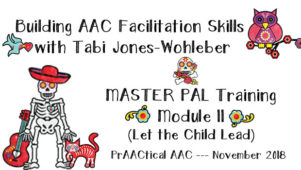
Today, Tabi Jones-Wohleber shares the last module in the MASTER PAL training series, which provides tips and strategies for working with children who don’t yet demonstrate joint attention. This module should take 30-40 minutes to present. Join us next week as we do a final wrap-up with suggestions on using this training series in your AAC work. ::::::::::::::::::::::::::::::::::::::::::::::::::::::::::::::::::::::::::::::::::::::::::::::::::::::::::::::: Model as a MASTER PAL Module 11: Let the Child Lead Facilitator Guidelines It can be really difficult to get communication started with a child who does not demonstrate joint attention. This module explores tips and strategies for traveling with a child on their journey from preoccupation with seeking sensory input/inattention to learning, engaging, and communicating. Because learning emerges from meaningful social emotional experiences, letting the child lead can go a long way toward being invited into their world. Then learning can happen! Here are some things you will need for this... [Read More...]
October 22, 2018
by Carole Zangari -
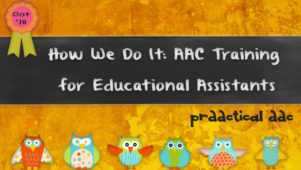
We’ve been focusing on training communication partners recently and today we’re focusing specifically on paraprofessionals/educational assistants. Our guest post is authored by SLPs Corinna Duffitt, M.Sc., RSLP (practicing for 21 years, 14 years in AAC) and Jennifer Wiegert, M.A., CCC-RSLP (practicing for 21 years, focusing on AAC for the past 6 years). They are colleagues on an AAC team with 4 other SLPs in a large school district in Surrey, BC, Canada. Their school district consists of 101 elementary schools and 20 secondary schools. Corinna and Jennifer are both passionate about giving children a voice and letting that voice uncovers their potential. They recently joined their private practice endeavours, outside of their public school positions, to form Chickadee AAC Communication Services. You can find them on Instagram (@chickadeeaacslps or #chickadeeaac), check in on their website, and/or follow them on Facebook. :::::::::::::::::::::::::::::::::::::::::::::::::::::::::::::::::::::::::::::::::::::::::::::::::::::::: AAC Training for Educational Assistants Some of the challenges we encountered... [Read More...]
October 4, 2018
by Carole Zangari -
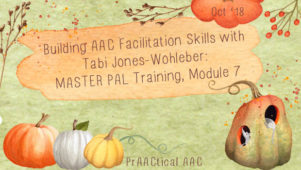
Welcome back to our AAC partner training series, Model as a MASTER PAL, created by SLP Tabi Jones-Wohleber. Today, we continue with materials to help communication partners interact with AAC learners in a supportive fashion. ::::::::::::::::::::::::::::::::::::::::::::::::::::::::::::::::::::::::::::::::::::::::::::::::::::::::::::::::::::::::::::::::::::::::::::::::::::::::::::::: Model as a MASTER PAL Module 7: Engage Naturally Facilitator Guidelines This module covers a lot of territory. From the behaviors of communication partners that support the process of language development to creating communication opportunities, to the language we use with a child to talk about their device, to fostering communicative competence, naturalistic engagement is shaped in many ways. The importance of this conversation lies in the fact that genuine engagement and mutual respect are where learning happens. It is also how meaningful social relationships are built. This module invites participants to reflect on factors that shape the quality of interactions in order to maximize the potential for communicating, learning and creating meaningful social,... [Read More...]
September 27, 2018
by Carole Zangari -
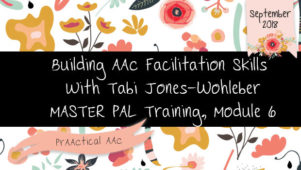
Let’s be honest: The most advanced AAC device in the world isn’t going to be very helpful unless it’s well-implemented. That’s why it is so important that communication partners, particularly those who spend lots of time with people use AAC, get training on ways to support the AAC learner. Tabi Wohleber-Jones is back with us today to share the 6th module in the MASTER PAL series. This module is all about time. Model as a MASTER PAL Module 6: Time: Wait-Time, Think-Time and Time for Language to Develop Facilitator Guidelines This 6th module in Model as a MASTER PAL explores both short-term and long-term factors related to time, as necessary for AAC skill development. These modules may be explored in a single learning session or split into two sessions, 20-30 minutes each. Firstly, language development occurs gradually over time, years actually. Teaching language with AAC takes time as well. ... [Read More...]









